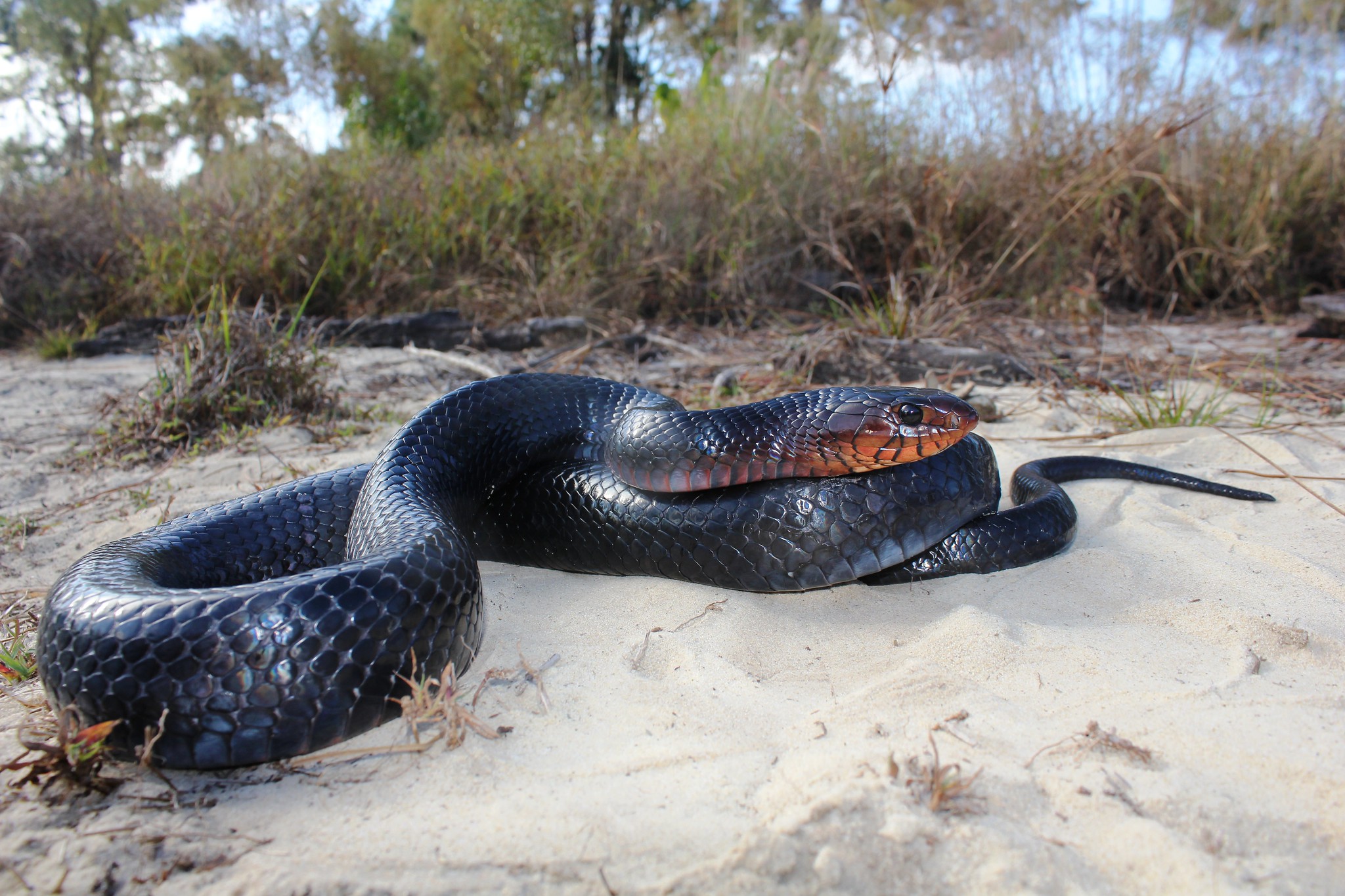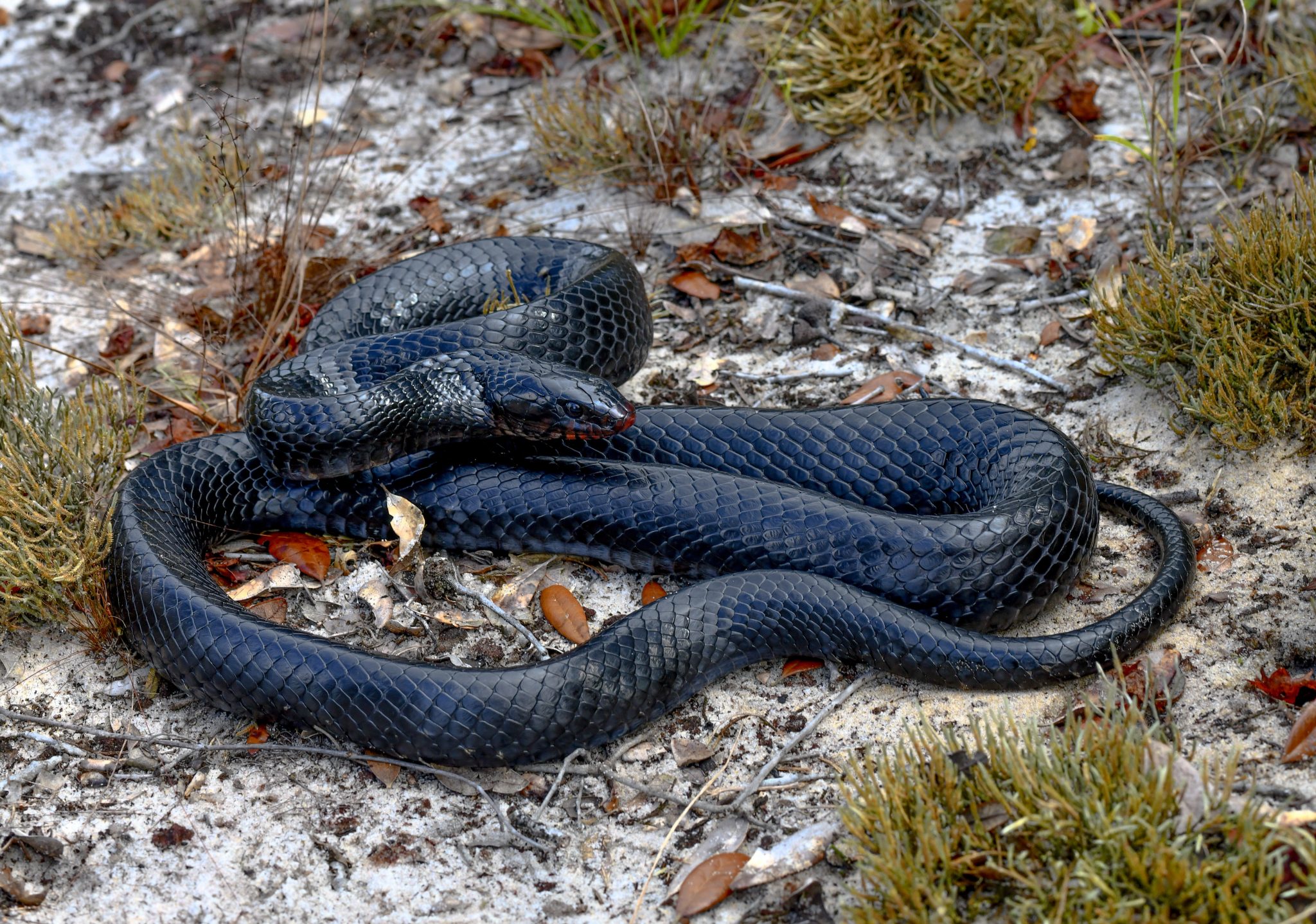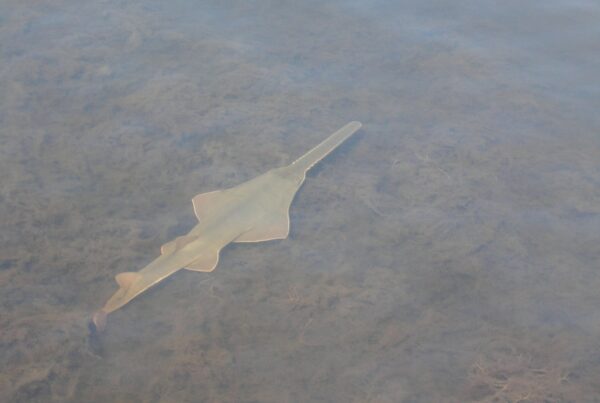In celebration of World Snake Day on July 16, we’re shining a light on one of Florida’s most iconic and misunderstood reptiles: the eastern indigo snake (Drymarchon couperi).

Eastern indigo snake. Photo by Kevin Enge | FWC
Florida is home to more than 50 species of native snakes, each playing a unique role in the web of life. But few stand out like the eastern indigo. With its iridescent, blue-black scales and impressive size, this nonvenomous species is not only a striking sight in the wild but a vital part of Florida’s ecosystems. The eastern indigo snake can grow over 8 feet long, making it the longest native snake in North America. Despite its size, this snake is shy, non-aggressive, and poses no threat to humans. In fact, its diet includes a variety of small animals, including venomous snakes like rattlesnakes—making it an important predator in Florida’s food web.
Eastern indigo snakes once ranged throughout the southeastern U.S., but today they are primarily found in Florida and parts of southern Georgia, where they depend on longleaf pine sandhills, scrublands, and pine flatwoods. These habitats are not only scarce but also increasingly fragmented due to development.
A Species in Decline
Due to habitat loss, fragmentation, and historic overcollection, eastern indigo snakes are now federally listed as threatened. Their decline is closely linked to the degradation of the longleaf pine ecosystems they call home—ecosystems that have been reduced to just a fraction of their historic range.

Eastern indigo snake. Photo by Tasman Rosenfeld
FWF and partner organizations are working to protect and restore these critical habitats through land conservation. These efforts benefit not just indigo snakes, but a wide range of native Florida species.
Why They Matter
Eastern indigo snakes are considered an umbrella species, meaning that efforts to protect their habitat benefit a wide range of other wildlife. Because indigos require large, connected territories and healthy ecosystems to thrive, conserving land for them also helps safeguard entire biodiversity hotspots.
One of the most critical relationships is with the gopher tortoise, a fellow keystone species. Indigo snakes often rely on abandoned or active tortoise burrows for shelter, especially during cooler months. These burrows can host more than 300 other species, making them vital hubs of life in Florida’s uplands.
By protecting indigo snake habitat—like longleaf pine sandhills, scrub, and pine flatwoods—we’re also preserving homes for fox squirrels, burrowing owls, Florida mouse, pollinators, and a variety of native plants. These habitats are among the most imperiled in the southeastern U.S., making restoration and conservation efforts all the more urgent.
In short, when we protect the eastern indigo snake, we’re protecting a much larger web of life, helping ensure that wild Florida stays wild.
Help Us Keep Florida Wild
As we recognize World Snake Day this July, take a moment to learn more about Florida’s incredible native snakes and the important roles they play in our ecosystems. Conservation starts with awareness, and every species has a story worth telling.
By supporting land conservation, you’re helping protect the habitats that species like the eastern indigo snake rely on to survive. From longleaf pine forests to gopher tortoise burrows, your gift helps us safeguard Florida’s wild places for generations to come.






I grew up in Broward County at a time that wasn’t developement bound. Plenty of undeveloped forests all around us. Every day was a holiday for me, romping in the woods coming across all kinds of native species, including snakes, such as rattlesnakes, pygmy and others,racers, garden,
Red and yellow corn, red-necks and especially Indigo’s. King snakes, water snakes. Let’s not forget the gopher and painted turtles. Birds of all kinds and the possums, raccoons, and skunks that I came across. I’m sure I’ve left out some, but I had a lively impressive native experience that I will never forget. Thank you for reading,
Jeanette P J…💝
Thank you for posting this as a grown mother who used to follow her boys around on vacations ( I was always worried they’d pick up something wild like a venomous snake or lizard I lived out west for a while so I knew what rattlers could do , this is a good snake that can Conquer the bad snakes Thank You National Wildlife Federation for teaching us the public ,
Love these beautiful big indigo snakes! I used to do a lot of hiking with the Sierra Club in the Sam Houston National Forest and there were quite a few great big king snakes that used to lie across the trails and rest or sunbathe, I don’t know what. Very gentle and lovely.
That Bee is absolutely gorgeous.
❣️❣️❣️🙏🙏🙏
The Eastern Indigo a beautiful black snake. I have seen them stretched across a road with the head on one side already a foot in and the tail still isn’t on the road. They are harmless and they eat mice , moles and all those varments that carry illnesses. The snake is not the pest.Please be kind to our wildlife. Just run in the opposite direction. That’s what they are doing.
Extremely important, especially now when climate change holds uncertainty for the future of all wildlife.
Very beautiful the color is spectacular!
Like this story reporting,,, thanks
I always liked the indigo snake. I didn’t know that there was a snake day in July. I also didn’t know that they could grow to be 8 feet along. I love everything about nature right down to the ants. Thank you
Great reading for all too read.
Holds your attention, from start
to finish. Thanks
Nice to read something important to our ecosystem and our future generations to our children’s lives
Great work. Thanks for the information. Please continue do what you’re doing. I wish more people take the time out to get Themselves are climated on the environment we live in. Thanks a million.
New n interesting